Tiling
Tile surfaces arable,
and—if you’re patient—fairly easy to install. Yet although tile has a hard finish, the ultimate durability of the installation depends on the integrity of what lies beneath.
There’s a riot of tiles to choose from, including slate, white porcelain hexagonals, ruddy Mexican pavers, tumbled marble, glass mosaic, brick veneer, cast cement, limestone quarry tile embedded with fossils, and so on. You can even paint your own designs on unglazed tiles and then have them kiln-fired. Although some types of tile are better suited to certain uses than others, finding a tile you like is rarely a problem.
► Where will you use it? Does it need to be waterproof? Does it need to withstand kitchenware?
► Sketch the area to be tiled. Include dimensions, fixtures, corners, odd jogs, and adjoining surfaces such as wood flooring or carpet. This sketch is a systematic first step in assembling a materials list.
► Choose a tile store with knowledgeable staff that will take the time to answer your questions. Plan to visit the shop on a weekday, which is likely to be less busy and thus a good time to get extra help. High-end tile stores have room mockups and may also have a Web site showing a wide selection of tiled kitchens and baths. Stores will also display many types of tile in 2 ft. sq. or 3 ft. sq. panels. Such visual expanses of tile convey much more than single-tile samples.

 Decorative and durable, tile can handle high humidity and heavy use-making it a great choice for kitchens and baths. A little Mexican, a little Moorish, this bathroom is always sunny.
Decorative and durable, tile can handle high humidity and heavy use-making it a great choice for kitchens and baths. A little Mexican, a little Moorish, this bathroom is always sunny.
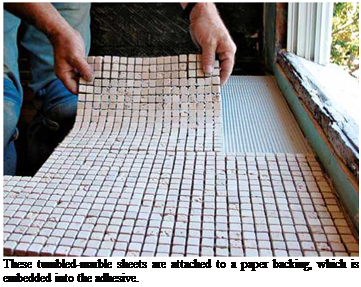
![]()
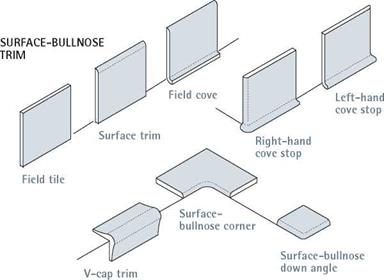
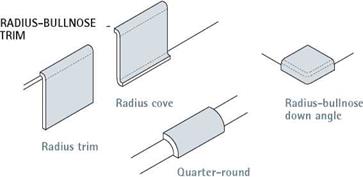 expensive. Also check on availability. Will specially ordered tile arrive in time to meet your renovation schedule?
expensive. Also check on availability. Will specially ordered tile arrive in time to meet your renovation schedule?
► Determine if trim tile is available for the pattern or type of field pattern you select. Trim tile is used to finish edges and corners and is especially important for counter installations.
► Test a tile sample at home. Here, you want to determine its suitability for your intended location by simulating actual use; for example, by scuffing it with shoes, banging it with pots, or dribbling it with water to check for absorption. Does the tile clean easily?
Color and size. In general, smaller tiles are better suited for small areas, such as counters. Larger tiles are more appropriate for larger areas, such as patio floors. Because light-colored tiles reflect more light, they make a room seem larger. Conversely, dark tiles make a room seem smaller. However, light colors tend to show dirt more readily. Vivid colors or busy designs can provide nice accents, but when used to cover large areas, they may seem overpowering.
Grout is a specialized mortar that seals the joints between tiles. Its color can make a big impact on the overall look. The closer the grout color matches the tile color, the more subdued and formal the surface. The more contrast between grout and tile, the busier, more festive, or more geometric the tile job will appear and the more it will highlight your tiling skill.
Manufactured vs. handmade. Mass-produced ceramic tile is popular because it has a clean classical look, and its uniform size makes it easy to install. Most smaller (й-in. to 2-in.) mass – produced tiles come evenly spaced and premounted on paper sheets or fiberglass mesh, allowing you to simply to align the sheets’ edges.
|
|
Trim tile is specially shaped to trim or finish off surface edges, corners, and the like and is thus distinguished from the main body of common, or field, tile. Trim tile is further classified as surface (or surface bullnose) and radius (or radius bullnose). Surface trim is essentially flat tile with one rounded edge. Radius trim, also known as quarter-round, curves dramatically to conceal the built-up bed on which it is set. Both types of trim include a range of specialty pieces that finish inside corners, outside corners, wall joints, and so on.
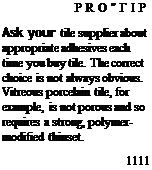
![]()
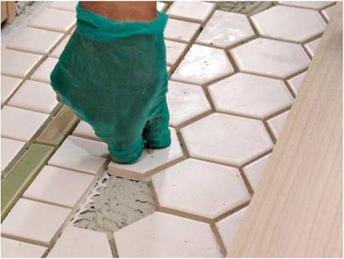
Handmade tiles offer unique color and a handsome, handcrafted look. But these irregular tiles take greater patience and skill to lay out and install. Often handmade tiles need thinset adhesive applied to each back, as well as a thinset layer-troweled onto a setting bed. Because they are irregular, handmade may also need to be arranged with plastic spacers to align their edges with the underlying layout lines.
Sheet-mounted tiles. Some tile comes either face mounted or back mounted, typically on 12-in. by 12-in. sheets. You install face-mounted tiles by leaving the paper facing on till the adhesive dries. Then dampen the paper and remove it. Disadvantage: Paper facing obscures tile joints, making them tougher to align. Back-mounted sheets are easier to align, but the bond between the tile and the adhesive may be compromised slightly because the backing remains stuck in the adhesive.






Leave a reply